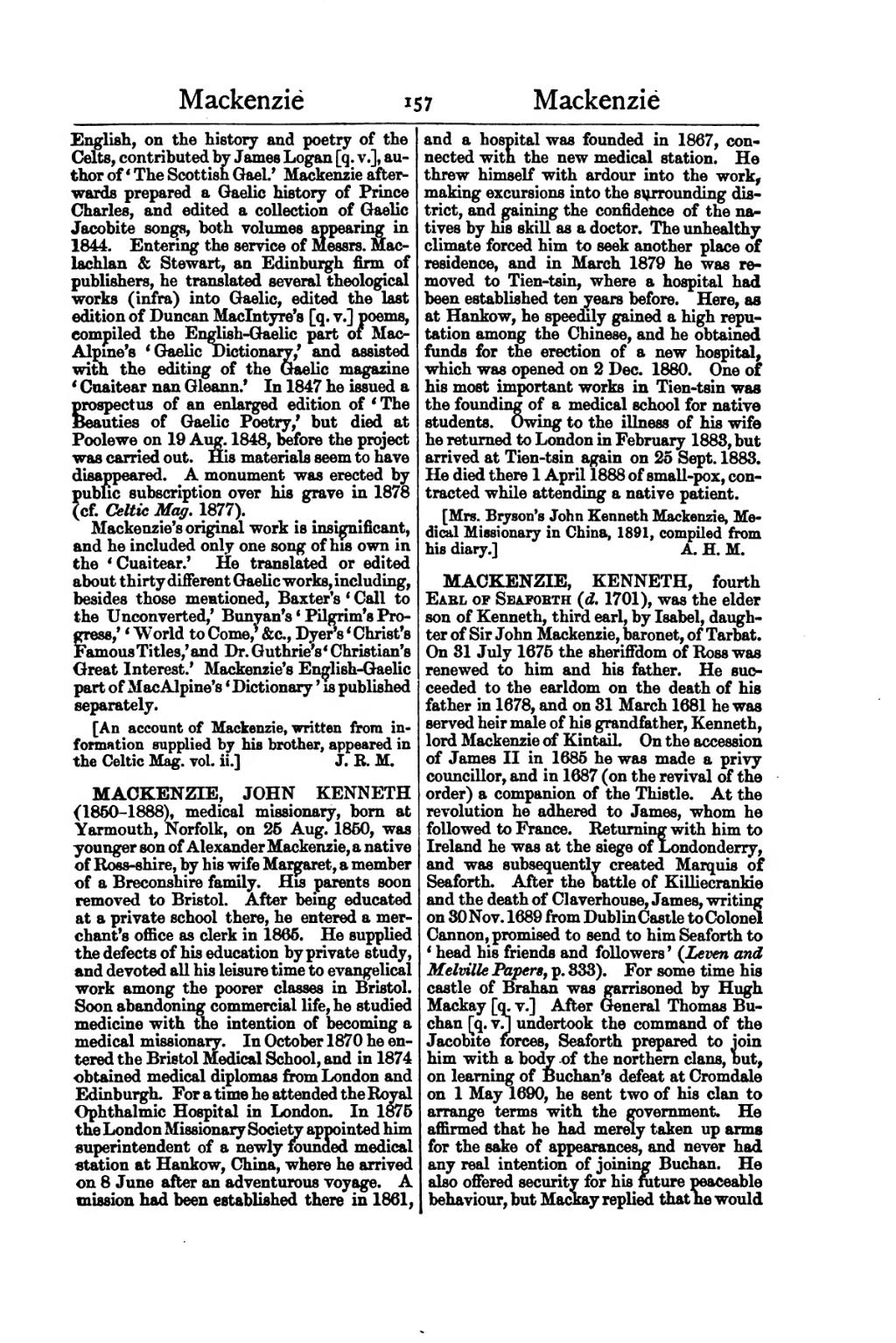English, on the history and poetry of the Celts, contributed by James Logan [q. v.], author of 'The Scottish Gael.' Mackenzie afterwards prepared a Gaelic history of Prince Charles, and edited a collection of Gaelic Jacobite songs, both volumes appearing in 1844. Entering the service of Messrs. Maclachlan & Stewart, an Edinburgh firm of publishers, he translated several theological works (infra) into Gaelic, edited the last edition of Duncan MacIntyre's [q. v.] poems, compiled the English-Gaelic part of MacAlpine's 'Gaelic Dictionary,' and assisted with the editing of the Gaelic magazine 'Cuaitear nan Gleann.' In 1847 he issued a prospectus of an enlarged edition of 'The Beauties of Gaelic Poetry,' but died at Poolewe on 19 Aug. 1848, before the project was carried out. His materials seem to have disappeared. A monument was erected by public subscription over his grave in 1878 (cf. Celtic Mag. 1877).
Mackenzie's original work is insignificant, and he included only one song of his own in the 'Cuaitear.' He translated or edited about thirty different Gaelic works, including, besides those mentioned, Baxter's 'Call to the Unconverted,' Bunyan's 'Pilgrim's Progress,' 'World to Come,' &c, Dyer's 'Christ's Famous Titles,' and Dr. Guthrie's 'Christian's Great Interest.' Mackenzie's English-Gaelic part of MacAlpine's 'Dictionary' is published separately.
[An account of Mackenzie, written from information supplied by his brother, appeared in the Celtic Mag. vol. ii.]
MACKENZIE, JOHN KENNETH (1850–1888), medical missionary, born at Yarmouth, Norfolk, on 25 Aug. 1860, was younger son of Alexander Mackenzie, a native of Ross-shire, by his wife Margaret, a member of a Breconshire family. His parents soon removed to Bristol. After being educated at a private school there, he entered a merchant's office as clerk in 1865. He supplied the defects of his education by private study, and devoted all his leisure time to evangelical work among the poorer classes in Bristol. Soon abandoning commercial life, he studied medicine with the intention of becoming a medical missionary. In October 1870 he entered the Bristol Medical School, and in 1874 obtained medical diplomas from London and Edinburgh. For a time he attended the Royal Ophthalmic Hospital in London. In 1875 the London Missionary Society appointed him superintendent of a newly founded medical station at Hankow, China, where he arrived on 8 June after an adventurous voyage. A mission had been established there in 1861, and a hospital was founded in 1867, connected with the new medical station. He threw himself with ardour into the work, making excursions into the surrounding district, and gaining the confidence of the natives by his skill as a doctor. The unhealthy climate forced him to seek another place of residence, and in March 1879 he was removed to Tien-tsin, where a hospital had been established ten years before. Here, as at Hankow, he speedily gained a high reputation among the Chinese, and he obtained funds for the erection of a new hospital, which was opened on 2 Dec. 1880. One of his most important works in Tien-tsin was the founding of a medical school for native students. Owing to the illness of his wife he returned to London in February 1883, but arrived at Tien-tsin again on 25 Sept. 1883. He died there 1 April 1888 of small-pox, contracted while attending a native patient.
[Mrs. Bryson's John Kenneth Mackenzie, Medical Missionary in China, 1891, compiled from his diary.]
MACKENZIE, KENNETH, fourth Earl of Seaforth (d. 1701), was the elder son of Kenneth, third earl, by Isabel, daughter of Sir John Mackenzie, baronet, of Tarbat. On 31 July 1675 the sheriffdom of Ross was renewed to him and his father. He succeeded to the earldom on the death of his father in 1678, and on 31 March 1681 he was served heir male of his grandfather, Kenneth, lord Mackenzie of Kintail. On the accession of James II in 1685 he was made a privy councillor, and in 1687 (on the revival of the order) a companion of the Thistle. At the revolution he adhered to James, whom he followed to France. Returning with him to Ireland he was at the siege of Londonderry, and was subsequently created Marquis of Seaforth. After the battle of Killiecrankie and the death of Claverhouse, James, writing on 30 Nov. 1689 from Dublin Castle to Colonel Cannon, promised to send to him Seaforth to 'head his friends and followers' (Leven and Melville Papers, p. 833). For some time his castle of Brahan was garrisoned by Hugh Mackay [q. v.] After General Thomas Buchan [q. v.] undertook the command of the Jacobite forces, Seaforth prepared to join him with a body of the northern clans, but, on learning of Buchan's defeat at Cromdale on 1 May 1690, he sent two of his clan to arrange terms with the government. He affirmed that he had merely taken up arms for the sake of appearances, and never had any real intention of joining Buchan. He also offered security for his future peaceable behaviour, but Mackay replied that he would
